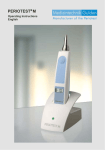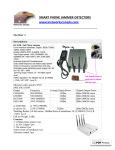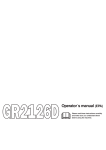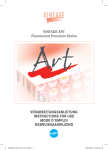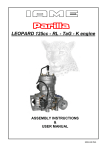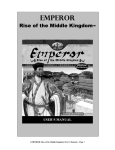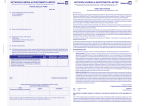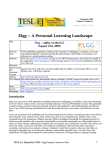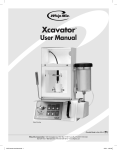Download VINTAGE Art LF
Transcript
VINTAGE Art LF INSTRUCTIONS FOR USE Introduction Thank you for purchasing our VINTAGE Art LF porcelain stains. Please read this user’s manual carefully before use to attain maximum benefits of this product. Kindly keep this manual for your future reference. VINTAGE Art LF low fusing fluorescent porcelain stains are designed to realize the internal and external modification of shades for all porcelain materials. Even the ready to use Glazing Paste is fluorescent and supports a lifelike color impression. In a very simple way the reproduction of every natural teeth characteristics can be created with a vital appearance in the laboratory and dental office. Contents 1 Notes on Use........................................................ 3 1-1.Notes............................................................ 3 1-2. Important Notes........................................... 3 2Characteristics...................................................... 3 2-1. Compatible with various Dental Ceramic Materials...................................................... 3 2-2. Easy to use Paste Stains............................. 3 2-3. Wide Variety of Colors & Shades (23 colors).................................................... 3 2-4.Fluorescence............................................... 3 3 System Components............................................ 4 4 Indications for Use................................................ 5 4-1. Colors and Indications................................. 5 4-2. Color Concept.............................................. 6 4-3. Example for Use.......................................... 7 5 Firing Schedule................................................... 13 6Troubleshooting.................................................. 14 2 1 Notes on Use 1-1. Notes (1) Keep away from flame or ignition source. (2) Wear protective glasses etc while grinding and polishing this product to avoid damages to the eyes. (3) Use local dust extractor, dust protective mask, etc while grinding this product to avoid harmful influence of the dust on the human body. (4) Do not mix this product with other stain products. (5) VINTAGE Art LF must only be used for the intended purpose. (6) VINTAGE Art LF must only be used by dental professionals. 1-2. Important Notes (1) If allergic reactions occur such as eruption or skin inflammation while using this product, discontinue use immediately and seek medical advice. (2) Avoid contacting soft tissues, skin or eyes. In case of eye contact, rinse immediately with plenty amounts of water and seek medical advice. 2 Characteristics 2-1. Compatible with various Dental Ceramic Materials VINTAGE Art LF low fusing paste stains can be used with various dental ceramic materials, such as lithium disilicate, press ceramics, zirconia / alumina based restorations, CAD/CAM porcelain blocks and PFM porcelain systems. 2-2. Easy to use Paste Stains Due to the ultra-fine particle structures the ready to use paste stains have excellent handling and application properties as well as superb covering characteristics. The appliance of a thin layer can easily be done from beginners to experienced ceramists. 2-3. Wide Variety of Colors & Shades (23 colors + Glazing Paste) The VINTAGE Art LF stain concept consists of primary stain colors (Pink, Blue and Yellow), secondary stain colors (Orange, Green and Violet) and shade stain colors (Shade Stains). In total 23 colors are available to meet the requirements of various esthetic restorations. Complicated mixing is not necessary in either clinical case, so the application work becomes easier. 2-4. Fluorescence VINTAGE Art LF are fluorescent stains which match the fluorescence of natural dentition and enhances the vitality of the ceramic restorations. 3 3 System Components Effect Set (18 colors) ●● Glazing Paste (5g) Pink, Rose-Pink, Corn-Yellow, Blue-Gray, Gray, Orange, Violet, Wine-Red, Vanilla, White, Orange-Brown, Black-Brown, Khaki, A-Shade, B-Shade, C-Shade, D-Shade (3g each) VINTAGE Art Stain LF Mixing Liquid 50 ml ●● Color Card ●● Instructions Refills (23 colors + Glazing Paste) Glazing Paste (5g) Pink, Yellow, Blue, Orange, Violet, Green, Black, White, Dark-Red Brown, Brown, Orange-Brown, Black-Brown, Khaki, Gray, Blue-Gray, Corn-Yellow, Rose-Pink, Wine-Red, Vanilla, A-Shade A, B-Shade, C-Shade, D-Shade (3 g each) VINTAGE Art LF Mixing Liquid 50 ml System Components 4 4 Indications for Use 4-1. Colors and Indications Color Shade Glazing Paste GP Pink P Yellow Y Blue Bl Orange O Violet V Green Gr Black B White W Dark-Red Brown DR-Br Brown Br Orange-Brown O-Br Black-Brown B-Br Khaki K Gray G Blue-Gray Bl-G Corn-Yellow CY Rose-Pink RP Wine-Red WR Vanilla Vn A Shade AS B Shade BS C Shade CS D Shade DS Use example Gingival Incisal Proximal shade ○ Stain ○ ○ ○ ○ ○ ○ ○ ○ ○ ○ ○ ○ ○ ○ ○ ○ ○ ○ ○ ○ ○ ○ ○ ○ ○ ○ ○ ○ ○ ○ ○ ○ ○ ○ ○ ○ ○ ○ ○ ○ ○ ○ ○ ○ ○ ○ Indications for Use 1 2 3 4 5 6 7 8 9 10 11 12 13 14 15 16 17 18 19 20 21 22 23 24 Shade Code adjustment Cervical 5 4-2. Color Concept The color concept of the VINTAGE Art LF system is logically structured in three main color groups. 1. Base Color Stains The esthetic color concept includes primary colors, secondary colors and achromatic colors. Primary colors (P, Y, Bl) Secondary colors (O, Gr, V) Achromatic colors (W, G, B) 2. Color Stains Based on these shades all individual colors and color adjustments can be achieved for the reproduction of every individual tooth characteristic. Vn 3. Shade Stains (AS, BS, CS, DS) Indications for Use The coloration in the desired shade group of finished Lithium disilicate, milled, pressed or layered porcelains can be obtained just by a surface application with these stains. These shades offer unique possibilities for obtaining three-dimensionally with metal-free and metalbonded porcelain works. This can be achieved by direct application of a thin layer on the Opaque or Liner. 6 4-3. Example for Use Hint Please mix the Paste Stains well with a plastic spatula before usage. If an adjustment of the viscosity is needed, please add a small quantity of Stain Liquid according to the personal requirements. Moisten the grinded and cleaned surface with a thin layer of VINTAGE Art LF Stain Liquid, apply the Paste Stains pure or mixed and fire according to the firing schedule. The viscosity of the fluorescent Glazing Paste can be modified as well by mixing with VINTAGE Art LF Stain Liquid. 1. Base Color and Hue Color Circle The above hue color circle displays the primary colors such as Pink, Yellow and Blue. Between the primary colors the secondary colors are located. In the center of the hue color circle there are the achromatic colors. The opposing colors of the hue color circle are called “complementary colors” and are neutralizing each other, which means that when mixed in equal quantities opposing shades turn gray. This is based on the subtractive color mixing theory. Indications for Use Achromatic colors such as White, Gray and Black can be used for the adjustment of brightness (value). In addition Gray and Black can reduce the light reflection by applying on the surface of Opaque Porcelain or Opaque Liner. If White is mixed adequately, adjustment of opacity is possible. 2. External Adjustment of Shades By mixing the colors in different quantities the intensity of the hue color increases and the value is reduced. By utilizing complementary colors, for example, if the Green tone should be reduced, reddis color as the complementary color of Green can be applied to adjust the tooth shade. 7 3. Recommended Stains for the Shade adjustment (chroma and hue) Shade Stains are recommended for the shade adjustment of finished ceramic restorations. Shade Stains (AS, BS, CS, DS) They should be applied on the porcelain surface to adjust the chroma and hue of the shade. Example: In order make strong A Shade, AS (A-Shade) is applied. Indications for Use Hint 8 Since Shade D4 has a different hue, an appropriate amount of B-Shade shall be mixed with D-Shade. 4. Outer Staining Interproximal, cervical and occlusal applications (ridges, fissures and cusps) To create an individual occlusal surface, Orange and Brown can be applied thinly at the centre of the occlusal area. Dark-Red-Brown can be placed in the fissure by using a very small brush. The cusps can be emphasized with White, Orange or Blue. For interproximal and cervical areas, Shade Stains or Khaki can be selected depending on the clinical case. Adjustment of occlusal center Adjustment of pits and fissures Indications for Use Shade application of white bands and decalcifications To create white or bright bands or decalcification areas, White, Vanilla or Corn Yellow can be used individually or mixed with a brush or a fine instrument. A 1:1 mixture is often required. It is also possible to stain these effects internally after the first firing of body. Vanilla White band Decalcification 9 Shade application on the incisal area (adjustment of translucency) To intensify the translucency of the incisal area and to adjust the light reflection, Blue-Gray, Gray, Violet or Orange can be thinly applied palatinally. The frontal application of Paste Stains creates a stronger coloration. Adjustment of cervical translucency Applications of stains, hair lines and crack lines Strong staining and discoloration – such as experienced by smokers and tea drinkers can be accurately reproduced with Dark-Red-Brown, Black-Brown or Brown with a small brush. To create hair lines, Dark-Red Brown, Black-Brown or Brown are recommended. The thickness, length or position of the lines is adjusted with a clean brush by eliminating excess of stain materials. Crack lines can be also created by using White / Vanilla or a mixture of White and Orange instead of Brown. Indications for Use Hair line crack Staining of nicotine or food Shade application of reddish gum effects on the cervical area The shade of the cervical area of natural teeth is slightly reddish because of the reflecting gum color. Fine adjustment for reddish gum effects on the cervical areas can be achieved by using Pink, Rose-Pink or Wine Red. Pink, Rose-Pink or WineRed are designed gum colors used to enhance the reddish appearance on the cervical area. Vanilla 10 Natural teeht Image of cervical shade Staining of Gingiva Porcelain Especially for implant supported restorations the stain colors Vanilla, Pink, RosePink or Violet are recommended for creating individual gum colors. Brown and Black-Brown are also used to create melanin discoloration or gingival sulcus. Adjustment of gum color Staining of Llithium dislicate, press ceramic / CAD / CAM crowns Any required color adjustment and natural individualisation after pressing or milling can be achieved with VINTAGE Art LF Stains. •Basic shades with stains AS or BS •Enamel effects with Blue-Gray, White / Vanilla and Gray •Cervical effects with Khaki, Brown, Orange Brown or Dark Red Brown Contour the final form and clean briefly with Al2O3 Individualize with VINTAGE Art LF stains and perform an outer porcelain staining firing Then apply VINTAGE Art LF Glazing Paste and perform an outer glazing firing Indications for Use Lithium disilicate restoration after divesting 11 5. Inner Staining Designing of mamelon shapes and adjustment of translucency If the mamelon structure is clearly expressed, Vanilla, Orange or Pink can be applied onto the mamelon structure for reducing the dominance. Vanilla Adjustment of mamelon structure Emphasized mamelon structure Shade application on the incisal area (adjustment of translucency) To intensify the translucency of the incisal area and to adjust the light reflexion, Blue-Gray, Gray, Violet or Orange can be thinly applied palatinally. The frontal application of Paste Stains creates a stronger coloration. Indications for Use Note 12 Adjustment of translucency (1) Use clean spatula or brush to dispense this material from the container. Water should be eliminated completely from the spatula or the brush before use. Entrapping water cases air bubbles. (2)Dispense necessary amount of paste and mixing liquid. Do not put remaining material back into the container. (3)Stain paste must be mixed with clean spatula before dispensing on the palette or glass slab. Close the cap tightly immediately after dispensing. (4) Use VINTAGE Art LF Stain Liquid to adjust the viscosity of the paste. Do not use water or other mixing liquid. (5)Use the materials immediately after dispensing. (6)Do not touch the material with bare hands. 5 Firing Schedule For use of inner porcelain staining Drying °C 450 Drying Vacuum Start Inc. Temp. Final Temp. Vacuum End min. °C °C / min. °C °C 5 50- 60 715 - Hold min. 0 min. For use of outer porcelain staining Drying °C 450 Drying Vacuum Start Inc. Temp. Final Temp. Vacuum End Hold min. °C °C / min. °C °C min. 5 50-60 760 0.5 min. For use of outer glazing of Lithium disilicate Drying °C 450 Note Drying Vacuum Start Inc. Temp. Final Temp. Vacuum End Hold min. °C °C / min. °C °C min. 5 50-60 770 1.0 min. Depending on the type of porcelain furnace, the firing temperature varies, so a test firing is recommended before usage. Firing Schedule 13 6 Troubleshooting Porcelain Stain Trouble Crack on stain surface Bubbles Drying of stain Cracking of porcelain Bubbles in porcelain Porcelain Solution Layer too thick Apply thin layer Layer too thick Drying temperature too high Drying time too short Firing temperature too high Firing tray temperature too high Contamination of application surface Contamination of Stain Liquid with water Stain Paste is not in smooth condition Cap was not sealed tightly and liquid evaporated Apply thin layer Dry with appropriate temperature Dry with appropriate time Fire with appropriate temperature Place firing tray at least 2-3 minutes after firing stage is open Clean the abrasive dust with sandblasting machine Avoid contamination with water (for cleaning of the brush the use of Stain Liquid is necessary) Mix well with a spatula before usage Add VINTAGE Art LF Stain Liquid and mix well Too thick layer Apply with thin layer and fire Too thick layer and bubble included Apply with thin layer and fire Lifting of porcelain Too high firing due to shrinkage temperature Troubleshooting White discoloration of porcelain 14 Cause Porcelain was contaminated by Stain Liquid If the stain surface is too shiny, select a lower temperature so that the stain surface does not get a shiny surface (lower the temperature) Stain is applied after firing of porcelain (Stain Liquid consists of organic elements and it should not be mixed with porcelain powder, as it is difficult to evaporate) 15

















